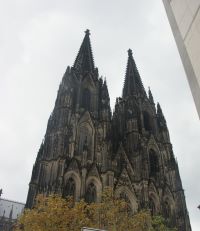Reminiscences 2024
The next stop was in Germany–Cologne, another town founded by the Romans. It became free city in the Holy Roman Empire, its bishop an Elector, until Napoleon annexed it to France. After the Congress of Vienna, it became part of Prussia, its Catholic majority uncomfortably married to Protestant Prussia. The city was heavily bombed in World War II–about 60% destroyed. Fortunately for posterity, the Gothic cathedral was spared, and the numerous Romanesque churches rebuilt with attention to detail. What else would you expect?

 If you have taken a course in Western Civilization, you have undoubtedly been introduced to the Cologne Cathedral (Cathedral Church of St. Peter, technically), Germany’s most visited landmark. Begun in 1248, and finally completed in 1880, it was the tallest building in the world until the completion of the Washington monument in 1890. The shrine of the three kings is reputed to hold relics from the 3 Wise Men who found Jesus.
If you have taken a course in Western Civilization, you have undoubtedly been introduced to the Cologne Cathedral (Cathedral Church of St. Peter, technically), Germany’s most visited landmark. Begun in 1248, and finally completed in 1880, it was the tallest building in the world until the completion of the Washington monument in 1890. The shrine of the three kings is reputed to hold relics from the 3 Wise Men who found Jesus.

 The city also boasts 12 Romanesque churches, dating from the fourth through the thirteenth centuries. St. Martin dates from 1000.
The city also boasts 12 Romanesque churches, dating from the fourth through the thirteenth centuries. St. Martin dates from 1000.
It is also famous for Eau de Cologne (I visited the museum, and learned the Eau was invented in 1709 by a transplanted Italian, and substituted for especially by royalty for a bath). I had a Kolsch, too, a beer protected in the European Union, meaning it’s made within 30 miles of Cologne, following definite procedures.
 Rudesheim brought us to Hesse, and vineyards. One claim to fame is a huge statue overlooking the Rhine that celebrates the
Rudesheim brought us to Hesse, and vineyards. One claim to fame is a huge statue overlooking the Rhine that celebrates the unification of Germany in 1871. It pictures Germania, symbol of the new country. There are abandoned castles around the city, and across the river Eibingen Abbey, founded by polymath Hildegard of Bingen; I’ve heard her music.
unification of Germany in 1871. It pictures Germania, symbol of the new country. There are abandoned castles around the city, and across the river Eibingen Abbey, founded by polymath Hildegard of Bingen; I’ve heard her music.

Miltenberg was our introduction to Bavaria (Wurzburg became part of the  Kingdom of Bavaria thanks to the Congress of Vienna) and Franconia, a cultural and linguistic area. Another town Roman paternity, it is probably best known for its
Kingdom of Bavaria thanks to the Congress of Vienna) and Franconia, a cultural and linguistic area. Another town Roman paternity, it is probably best known for its 
 half-timbered houses. One Zum Reisen is the oldest hotel in Europe, dating from 1400 or so, with the current building dating from 1590. And, of course, it will have a fortress.
half-timbered houses. One Zum Reisen is the oldest hotel in Europe, dating from 1400 or so, with the current building dating from 1590. And, of course, it will have a fortress.

 Wurzburg was one of the most devastated cities, but rose, like phoenix, from the ashes. 91% of the city was destroyed in a 17 minute bombardment. You’d never know it. The 18th century rebuilt Residence (of the Prince-Bishop) is a Baroque showpiece. The third and present Cathedral
Wurzburg was one of the most devastated cities, but rose, like phoenix, from the ashes. 91% of the city was destroyed in a 17 minute bombardment. You’d never know it. The 18th century rebuilt Residence (of the Prince-Bishop) is a Baroque showpiece. The third and present Cathedral  was consecrated in 1187 and rebuilt several times,
was consecrated in 1187 and rebuilt several times, including after World War II. I did the “walking tour” on a bicycle and managed to see many of the other sites in town, including a wonderful Baroque facade, and the fortress.
including after World War II. I did the “walking tour” on a bicycle and managed to see many of the other sites in town, including a wonderful Baroque facade, and the fortress.
We took a bus (I think) to Rothenburg au Tauber, the “Red Castle on the 
 Tauber” which the Nazis thought was the ideal German city. Unusual for the cities we visited, it was not founded by the Romans, and it’s not on the Rhine. Recognizing its historical importance on the Romantic Road in southern Germany, the Assistant Secretary of War told
Tauber” which the Nazis thought was the ideal German city. Unusual for the cities we visited, it was not founded by the Romans, and it’s not on the Rhine. Recognizing its historical importance on the Romantic Road in southern Germany, the Assistant Secretary of War told 
 the US Army not to use artillery in recapturing the city. Aerial bombardment had destroyed “only” a third. It is one of four cities with its medieval wall intact, but one of many with the obligatory fortress and churches.
the US Army not to use artillery in recapturing the city. Aerial bombardment had destroyed “only” a third. It is one of four cities with its medieval wall intact, but one of many with the obligatory fortress and churches.